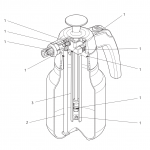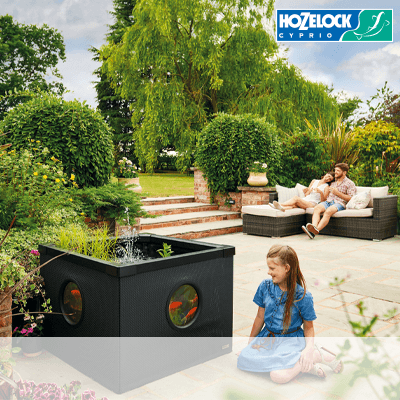DEHP Declaration
Risk Assessment on the use of DEHP in Hozelock Products
Terms of Reference: This risk assessment is produced to explain the risk connected with the use of DEHP, it does not cover other risks associated with DEHP containing products e.g. Lifting.
SVHC CAS Number: BIS (2-Ethylhexyl) Phthalate 117-81-7
DEHP
DEHP is a substance that is used as a plasticizer to make PVC plastic soft and flexible. It is a colourless and odourless organic chemical.
Plasticizers are essential to make PVC flexible. PVC is rigid by nature but plasticizers give it similar properties to rubber: it becomes flexible and expandable, whilst retaining its shape.
The use of DEHP has been carefully considered by EU scientists and it is already well regulated by European legislation relating to toys and childcare articles, cosmetics, food contact materials and medical devices. DEHP has been used for more than 50 years without a single known case of anyone having been harmed as a result.
DEHP is not classified as a human carcinogen or mutagen and it does not accumulate in humans or in the environment.
DEHP and REACH
REACH is the Regulation for Registration, Evaluation, Authorisation and Restriction of Chemicals. It entered into force on 1st June 2007 to streamline and improve the former legislative framework on chemicals of the European Union (EU).
Under the REACH legislation all chemicals will have to be registered for use with the European Chemicals Agency (ECHA) and certain chemicals will eventually have to be authorised for use if they are considered to be Substances of Very High Concern (SVHC).
On 28 October 2008, the European Chemicals Agency (ECHA) published a list of the first substances to enter onto the REACH authorisation “candidate list”. DEHP was included on the list due to its EU hazard classification.
On June 1 2009, ECHA recommended that DEHP is prioritised for entry into the REACH Annex. If – as is expected – the ECHA recommendation is accepted, the European Commission will amend the REACH Annex , and industry will have until around mid-2012 to apply for authorisation for uses of DEHP.
DEHP Risk Assessment.
The European Union has confirmed that DEHP poses no general risk to human health. The summary of a comprehensive European risk assessment, involving nearly 15 years of extensive scientific evaluation by EU regulators, was published in the EU Official Journal on February 7 2008 (Commission Communication C/2008 34/1 and Commission Recommendation L 33/8).
The assessment demonstrates that DEHP poses no risk to the general population and that no further measures need to be taken to manage the substance in any of its key end-use applications. The only areas of possible risk identified in the assessment relate to:
The use of DEHP in children’s toys: Under regulations introduced in January 2007 DEHP is no longer permitted in toys and childcare articles in the EU.
Possible exposure of workers in factories: But adequate precautions are already taken based on occupational exposure limit values.
Some localised environmental exposure near to factories: The European Union will shortly finalise measures relating to emissions controls from converters.
The use of DEHP in certain medical devices: An EU Scientific Review was requested to determine whether there may be any risk from the use of DEHP in certain medical applications (children and neonates undergoing long-term blood transfusion and adults undergoing long-term haemodialysis).
Possible environmental risk to river basins: to be addressed through the use of Environmental Quality Standards (which already exist for DEHP).
DEHP in Hozelock Products
Some Hozelock hosepipes contain up to 30% DEHP as a plasticizer. There are no legal restrictions on the use of DEHP in this application. However, in order to demonstrate a commitment to reducing the environmental impact of Hozelock products, Hozelock eliminated the use of DEHP from UK manufactured products in 2010. The final source of DEHP for Hozelock is our use of recycled materials. We will phase out and eliminate the DEHP compound from all our operations during 2011.
Warehousing & Receipt of Hozelock products containing DEHP
There are no health risk or special measures that need to be taken
Stock holding of goods in a retail store of Hozelock products containing DEHP
There are no health risk or special measures that need to be taken.
Handling of Hozelock products containing DEHP
There are no health risk or special measures that need to be taken.
Use of Hozelock products containing DEHP
This product should not carry water that is going to be consumed by humans or pets, it should not be chewed.
Disposal of Hozelock products containing DEHP
No special care, but like all plastic products, at end of life take to recycling facility, do not dispose in landfill, and do not destroy by burning
Issue 4
July 2011 APPROVED FOR GENERAL ISSUE














